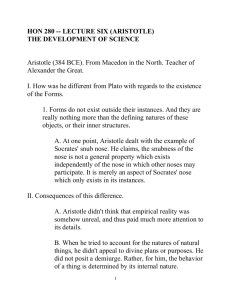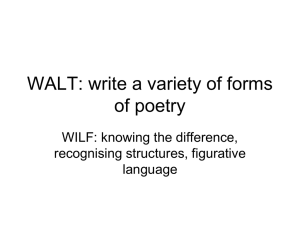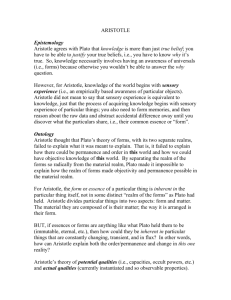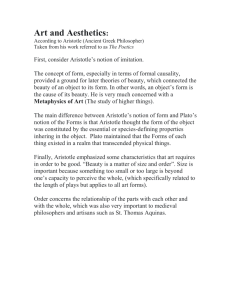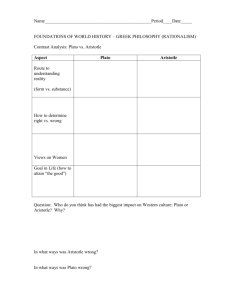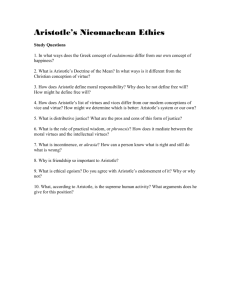03. Aristotle (384-322 B.C.) I. Matter and Form
advertisement
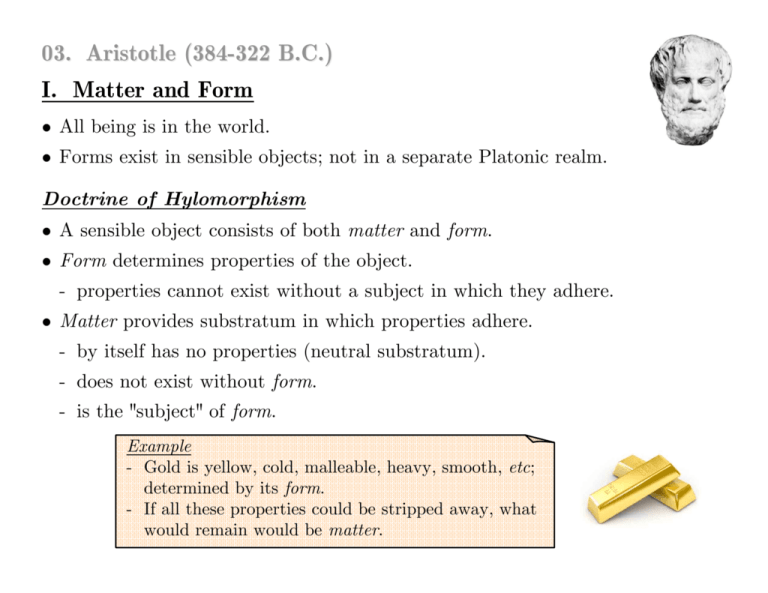
03. Aristotle (384-322 B.C.) I. Matter and Form • All being is in the world. • Forms exist in sensible objects; not in a separate Platonic realm. Doctrine of Hylomorphism • A sensible object consists of both matter and form. • Form determines properties of the object. - properties cannot exist without a subject in which they adhere. • Matter provides substratum in which properties adhere. - by itself has no properties (neutral substratum). - does not exist without form. - is the "subject" of form. Example - Gold is yellow, cold, malleable, heavy, smooth, etc; determined by its form. - If all these properties could be stripped away, what would remain would be matter. Aristotle's objection to Plato There can be no matter without form, and no form without matter (with one important exception). • Goal of natural inquiry = To identify the forms of things (classification of forms). This investigation must start in the sensible world (and not in the realm of reason). II. Change • Recall: Problem of change = How can the world exhibit both permanence and change? Consider the transformation of an acorn into a sapling. - How can we identify the sapling with the acorn? - How is this identity transfered during the transformation? ? Aristotle's Account of Change • Permanence through change is provided by matter. - When a sensible object changes, its form changes and its matter remains the same. • So: Change is fundamentally real. (Not an illusion. Not restricted to a lesser realm.) • But: What about Parmenides' Objection: Change requires the emergence of something from nothing. • Aristotle's Response: - Change is not a transition from non-being to being, but from potential being (potential form) to actual being (actual form). Example: • An acorn has both an actual form of being an acorn, and a potential form of being a sapling and an oak tree. • A sapling has both an actual form of being a sapling, and a potential form of being an oak tree. • When an acorn changes into a sapling, its potential form transitions into the actual form of a sapling. • So: Two distinctions underlie Aristotle's concept of change: - matter/form distinction (static) - potential/actual distinction (dynamic) • Pure potency = "Prime Matter" (but this doesn't exist: actuality is prior to potency). • Pure actuality = "Prime Mover" (Aristotle's concept of god). • This explains how change is possible. But it doesn't explain why change occurs: What is the cause of change? • Aristotle says: Things undergo change due to their natures ("things are what they do"). • The nature of a thing is its tendency to actualize its potential. • nature = an internal goal-directed cause of change. • The nature of an acorn is to become an oak tree. • The nature of a planet is to follow a perfect circular path in the heavens. • The nature of a rock is to fall to the center of the cosmos. - A rock has the actual form of heaviness and the potential form of being-at-the-center-of-the-cosmos. How is this different from contemporary accounts? • Consider Newton's 1st Law of Motion: Left unimpeded, a body will continue in a state of rest or in uniform motion along a straight line. • Why does a body do this? • Inertia = tendency of a body to obey the 1st Law of Motion. • The more inertia a body has, the greater its tendency to continue at rest or in uniform motion in a straight line. • Why do bodies have inertia? No explanation within contemporary physics. • For Aristotle, knowledge consists in knowledge of natures (in general, of understanding the causes of change): "If we are ignorant of change, then we are ignorant of Nature." Three Points to Remember about natures: 1. Not all things follow their natures and achieve their potentials: most things are impeded by interactions with other things. (Left unimpeded, all things would follow their natures.) 2. Only natural things have natures (and hence are sources of change). Artificial things do not have natures. 3. To determine natures, observation is sufficient. No need for intervention (i.e., controlled experimentation, repeatibility, etc.) III. The Four Causes 1. Material: What is it made of? (That in which change occurs.) 2. Formal: What kind of thing is it? (The form into which a thing changes.) 3. Efficient: How was it made? (That by which change is brought about.) 4. Final: What is it for? (That for the sake of which change occurs.) • Four ways of explaining what makes a thing what it is. • Operative in both Art (techne) and Nature (physis). marble statue of Zeus acorn 1. marble 1. material of acorn 2. shape of Zeus 2. oak tree 3. chisel and hammer 3. rain, sun, soil, nutrients 4. intent of sculptor 4. nature of acorn • Note overlaps: The nature of an acorn is also associated with its form. • In Art, final causes are external/transcendent. • In Nature, final causes are internal/immanent. • Is Aristotle deifying Nature with concept of final cause? • No: Nature does not have an overall purpose. • Rather: Natural processes are internally goal-directed. Example: Functional explanations in contemporary biology. - Why are grasshoppers green? - Typical answer: Camouflage is a valuable adaptive trait for grasshoppers. • But no explanations of this sort in contemporary physics: - Why does Saturn have rings? - Typical answer: The rings are the remnant of a moon that broke up in the distant past. • No appeal to any possible value of having rings for planets. • Explanations in contemporary physics tend to be framed in terms of efficient causes and not final causes. • Why? IV. Aristotle's Cosmology 1. The Four Elements element form earth cold/dry heaviest water cold/wet lighter1 air hot/wet lighter2 fire hot/dry lightest Transformations between elements: • Contrary forms = two forms that cannot both be present in the same thing. • Forms change via transitions between contraries. fire cold ⇔ hot wet ⇔ dry water ⇔ air water ⇔ earth earth ⇔ fire air ⇔ fire hot wet dry earth air cold water 2. The Cosmos • A series of concentric spheres divided into two realms: The Terestrial Realm (inside the sphere of the moon). Composed of the 4 elements. The Celestial Realm (between the sphere of the moon and the sphere of the fixed stars). Composed of aether. The spheres of the sun and planets. In order: Moon Sun Venus Mercury Mars Jupiter Saturn fixed stars Each dotted circle really represents a set of nested spheres... aether fire, air, water, earth Earth planet Earth Earth Earth Earth Earth Earth How many spheres? Earth Eudoxus Moon 3 Sun 3 Venus 4 Mercury 4 Mars 4 Jupiter 4 Saturn 4 fixed stars 1 27 Callippus 5 5 5 5 5 4 4 1 34 Aristotle 5 5+4 5+4 5+4 5+4 4+3 4+3 1 56 • Explains retrograde motion. • Aristotle requires additional spheres to counteract some of the motions of the planetary spheres. (These additional spheres are placed between the outermost sphere of a given planet and the innermost sphere of the next planet and are one less than the number of spheres of the latter.) 3. Motion • Two basic principles: I No motion without a mover in contact with moving body. II. Distinction between: (a) Natural motion: mover is internal to moving body (b) Forced motion: mover is external to moving body 3 Types of Natural Motion and Corresponding Elements (Natural Bodies) (1) In straight line towards center of the cosmos: earth, water (2) In straight line away from center of the cosmos: fire, air (3) In circle about center of the cosmos: aether ("fifth element") • Cause of celestial motion = Unmoved Mover ("Prime Mover"). - Acts as final cause ("object of desire") • Cause of terestrial motion = celestrial realm as final cause. - Cyclic transformation between elements emulates circular motion of heavens. 4. Doctrine of the Plenum • Claim: There is no void (contra the atomists). • Assume: (i) Speed is inversely proportional to resistence. (V ∝ 1/R) (ii) Infinite speed is physically impossible. • Conclusion: Zero resistence is physically impossible. • Hence: There can be no body through which motion can occur that has zero resistence (i.e., zero density; i.e., a void). • But: Could also conclude that Assumption (i) is incorrect. (Zero resistence doesn't necessarily entail infinite speed.)

